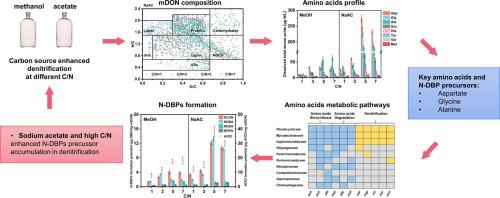Journal of Hazardous Materials ( IF 13.6 ) Pub Date : 2022-08-13 , DOI: 10.1016/j.jhazmat.2022.129775 Jie Wang 1 , Fang Zheng 1 , Zhaoniao Yu 1 , Jinrong Chen 2 , Huijie Lu 1

|
Microbially derived dissolved organic nitrogen (mDON) is a major fraction of effluent total nitrogen at wastewater treatment plants with enhanced nutrient removal, which stimulates phytoplankton blooms and formation of toxic nitrogenous disinfection by-products (N-DBPs). This study identified denitrifiers as major contributors to mDON synthesis, and further revealed the molecular composition, influential factors and synthetic microorganisms of denitrification-derived mDON compounds leading to N-DBP formation. The maximum mDON accumulated during denitrification was 8.92% of converted inorganic nitrogen, higher than that of anammox (4.24%) and nitrification (2.76%). Sodium acetate addition at relatively high C/N ratio (5−7) favored mDON formation, compared with methanol and low C/N (1−3). Different from acetate, methanol-facilitated denitrification produced 13–69% more lignin-like compounds than proteins using Orbitrap LC-MS. The most abundant N-DBPs formed from denitrification-derived mDON were N-nitrosodibutylamine and dichloroacetonitrile (13.32 μg/mg mDON and 12.21 μg/mg mDON, respectively). Major amino acids, aspartate, glycine, and alanine were positively correlated with typical N-DBPs. Biosynthesis and degradation pathways of these N-DBP precursors were enriched in denitrifiers belonging to Rhodocyclaceae, Mycobacteriaceae and Hyphomicrobiaceae. As intensive disinfection is applied at worldwide wastewater treatment plants during COVID-19, carbon source facilitated denitrification should be better managed to reduce both effluent inorganic nitrogen and DON, mitigating DON and N-DBP associated ecological risks in receiving waters.
中文翻译:

来自废水反硝化的溶解有机氮:成分和含氮消毒副产物的形成
微生物衍生的溶解有机氮 (mDON) 是污水处理厂出水总氮的主要部分,具有增强的养分去除能力,可刺激浮游植物大量繁殖并形成有毒的含氮消毒副产物 (N-DBP)。本研究确定反硝化菌是 mDON 合成的主要贡献者,并进一步揭示了反硝化衍生的 mDON 化合物导致 N-DBP 形成的分子组成、影响因素和合成微生物。反硝化过程中积累的最大mDON为转化无机氮的8.92%,高于厌氧氨氧化(4.24%)和硝化(2.76%)。与甲醇和低 C/N (1-3) 相比,以相对较高的 C/N 比 (5-7) 添加乙酸钠有利于 mDON 的形成。不同于醋酸盐,使用 Orbitrap LC-MS,甲醇促进的反硝化产生的类木质素化合物比蛋白质多 13-69%。由反硝化衍生的 mDON 形成的最丰富的 N-DBP 是 N-亚硝基二丁胺和二氯乙腈(分别为 13.32 μg/mg mDON 和 12.21 μg/mg mDON)。主要氨基酸、天冬氨酸、甘氨酸和丙氨酸与典型的 N-DBP 呈正相关。这些 N-DBP 前体的生物合成和降解途径富含属于红环菌科、分枝杆菌科和丝菌科。由于在 COVID-19 期间在全球污水处理厂进行了强化消毒,应更好地管理碳源促进的反硝化,以减少流出的无机氮和 DON,减轻受纳水体中与 DON 和 N-DBP 相关的生态风险。


























 京公网安备 11010802027423号
京公网安备 11010802027423号